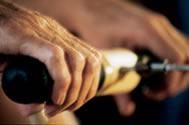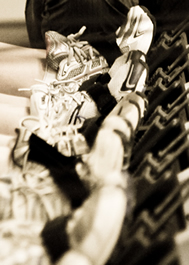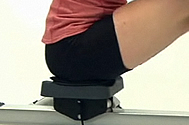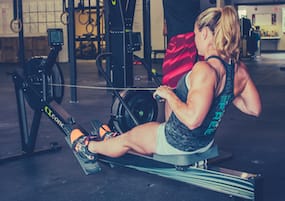In rowing, the body has three contact points with the rowing machine or boat: the hands, feet, and butt. Over time, these points can become uncomfortable. Fortunately, a little intervention—and patience!—goes a long way toward mitigating discomfort.
The Hands
 It’s no surprise that hands can take quite a beating from rowing. Blisters generally develop first, followed by calluses. The good news is that calluses offer protection: once your hands are callused, they should bother you less than when you first started. Even with calluses, be careful about suddenly increasing the duration of your rows—especially in hot or wet conditions, which accelerate blister formation. The key is to increase your rowing time gradually. Also, avoid letting your calluses get too thick. Clip or sand the top layer of dead skin when necessary.
It’s no surprise that hands can take quite a beating from rowing. Blisters generally develop first, followed by calluses. The good news is that calluses offer protection: once your hands are callused, they should bother you less than when you first started. Even with calluses, be careful about suddenly increasing the duration of your rows—especially in hot or wet conditions, which accelerate blister formation. The key is to increase your rowing time gradually. Also, avoid letting your calluses get too thick. Clip or sand the top layer of dead skin when necessary.
Gloves or No Gloves?
Wearing gloves while rowing is a personal choice. Customers who prefer gloves tell us that weightlifting gloves work well.
The Feet
 Of the three points of contact, the feet may have it the easiest—no gripping, no body weight, no impact. But, for ultimate comfort, it is important to find the right combination of socks and shoes. Choose good socks and shoes that aren’t too wide at the heel or have a heel with too much rise. (Wide heels can affect how well a shoe fits in the heel cup on the indoor rower, and shoes that rise too high may irritate your Achilles tendon at the finish of the stroke.)
Of the three points of contact, the feet may have it the easiest—no gripping, no body weight, no impact. But, for ultimate comfort, it is important to find the right combination of socks and shoes. Choose good socks and shoes that aren’t too wide at the heel or have a heel with too much rise. (Wide heels can affect how well a shoe fits in the heel cup on the indoor rower, and shoes that rise too high may irritate your Achilles tendon at the finish of the stroke.)
Shoes or No Shoes?
Like gloves, rowing with or without shoes is a personal choice. If you prefer to row without shoes, you may want to try a thicker sock that has some grip. If you need some padding behind your heels, try a piece of foam, bubble wrap or some rags wrapped around the base of the footstretcher.
For more on rowing with shoes, check out our blog post on Shoe Choice.
Setting the Flexfoot
Strapping your feet into the machine in the right spot affects foot and seat comfort. In general, your heel should be positioned in the footstretcher so that the strap crosses over the ball of your foot. If you row without shoes, you may want to adjust your feet higher; if you are less flexible or are carrying extra weight around your midsection, you may want to adjust your feet lower. Make sure you don’t place your feet so low that your hamstrings rest uncomfortably against the seat, cutting off circulation to the butt.
For more on the topic, check out our blog post: A Foot Position Primer.
The Butt
 The butt has a lot to do during rowing. It supports your body weight, serves as a pivot point, participates in the rowing stroke itself, and gets sat on the whole time. If your butt is not happy while you’re rowing, chances are the rest of you isn’t happy either.
The butt has a lot to do during rowing. It supports your body weight, serves as a pivot point, participates in the rowing stroke itself, and gets sat on the whole time. If your butt is not happy while you’re rowing, chances are the rest of you isn’t happy either.
What type of seat people like or dislike is as varied as the body part in question. The best thing to do is experiment. If you need extra padding, try a folded towel or a piece of bubble wrap. You could also try our seat pad or rowing shorts, which provide padding in a slightly different location than cycling shorts. If you’ve tried extra padding and your butt is going numb during your rows, try less padding: too much can cause cramping and numbness. If your tailbone is really taking a beating, make sure the seat is on the monorail correctly: the depression should be at the rear of the seat to accommodate the tailbone.
